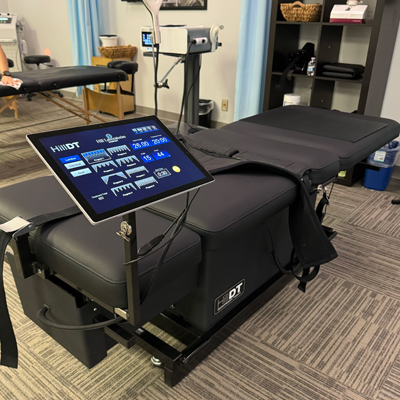Hill DT Spinal Decompression at Pure Relief Chiropractic
How does spinal decompression work?
Spinal decompression therapy is a non-invasive or minimally invasive treatment approach designed to alleviate symptoms and provide relief for individuals with certain spinal conditions. The therapy primarily aims to reduce pressure on the spinal discs and nerves, which can be beneficial for conditions such as herniated discs, bulging discs, degenerative disc disease, sciatica, and spinal stenosis. Spinal decompression can be delivered using various devices and techniques, and the general principles behind the therapy involve the following:
The primary goal of spinal decompression therapy is to decrease pressure on the spinal discs and nerves. This pressure can cause pain, discomfort, and other symptoms by compressing or irritating the nerves.
By reducing pressure on the spinal discs and nerves, spinal decompression therapy aims to alleviate pain and discomfort associated with various spinal conditions. It can also help improve range of motion and overall spinal function.
The negative pressure created during spinal decompression may encourage the retraction of herniated or bulging discs, allowing them to heal over time. Improved blood flow and nutrient delivery to the affected area can further support the healing process.
The patient is usually positioned on a treatment table or device that is specifically designed for spinal decompression. The setup may be for the lumbar (lower back) or cervical (neck) region, depending on the location of the spinal condition being treated.
Spinal decompression therapy relies on the application of a controlled traction force. This force is applied to the spine through the use of specialized equipment such as the Hill DT Table, which may be computer-controlled or manually operated by a trained healthcare provider.
The traction force gently stretches the spine, creating a separation or spacing between the spinal vertebrae. This stretching action aims to reduce pressure on the spinal discs and nerves, which can be compressed due to conditions like herniated discs, bulging discs, degenerative disc disease, or spinal stenosis.
As the spine is stretched, a negative pressure or a partial vacuum is created within the affected spinal discs. This negative pressure can help promote the retraction of herniated or bulging disc material back into the disc, reducing the pressure on nearby nerves.
The negative pressure within the discs can also encourage the inflow of nutrients, oxygen, and fluids into the discs. This may support the healing and regeneration of the spinal discs.
The treatment protocol for spinal decompression is typically customized for each patient. It may involve multiple sessions over a period of several weeks. The duration of each session and the amount of traction force applied can vary based on the specific condition and individual patient response.
Why is the Hill DT special?
 The Hill DT Spinal Decompression Table is a specific type of equipment designed for spinal decompression therapy, and it offers several features and benefits that differentiate it from other spinal decompression devices. The Hill DT table is known for its advanced technology and patient comfort. Here are some key differences and features that make the Hill DT unique for spinal decompression:
The Hill DT Spinal Decompression Table is a specific type of equipment designed for spinal decompression therapy, and it offers several features and benefits that differentiate it from other spinal decompression devices. The Hill DT table is known for its advanced technology and patient comfort. Here are some key differences and features that make the Hill DT unique for spinal decompression:
Advanced Computerized Technology: The Hill DT table is equipped with sophisticated computerized technology that allows for precise control of the treatment parameters, including decompression force, hold and relax times, and treatment progression. This technology ensures that the therapy is tailored to the specific needs of each patient and their condition.
Customizable Treatment Protocols: The table’s software allows healthcare providers to customize treatment protocols based on the patient’s diagnosis, condition severity, and individual response to therapy. This customization enhances the effectiveness and safety of the treatment.
Comfortable Patient Experience: The Hill DT table is designed with patient comfort in mind. It features a comfortable treatment surface and secure restraints that help patients relax during the procedure. The ergonomic design minimizes discomfort and anxiety commonly associated with other forms of spinal traction.
Precise Targeting of Affected Discs: The Hill DT table utilizes a unique clinical approach called the “Accu-Track System” that is designed to target the specific vertebral level or intervertebral disc causing the patient’s symptoms. This precision ensures that the therapy is focused on the problem area.
Progressive Traction Force: The table offers progressive and intermittent traction forces, allowing the spine to experience alternating cycles of decompression and relaxation. This can help promote better fluid exchange within the disc and stimulate tissue repair.
Safety Features: The Hill DT table is equipped with multiple safety features, including automatic patient recognition and real-time monitoring of the patient’s response to treatment. In the event of any unexpected reactions or issues, the treatment can be immediately adjusted or stopped.
Wide Range of Treatable Conditions: The Hill DT table is suitable for treating a wide range of spinal conditions, including disc herniations, disc bulges, sciatica, degenerative disc disease, and spinal stenosis.
Clinical Flexibility: Healthcare providers using the Hill DT table have the flexibility to adapt treatments to various patient profiles and clinical situations, making it a versatile option for spinal decompression therapy.
Is Spinal Decompression Therapy Right For You?
It’s important to note that the effectiveness of any spinal decompression therapy, including the Hill DT table, can vary depending on the specific condition and the individual patient’s response. The choice of treatment should be made in consultation with a qualified healthcare provider who can assess the patient’s specific condition and recommend the most appropriate treatment options. Additionally, a multidisciplinary approach to treatment, which may include chiropractic care, shockwave, laser, nutrition, and other conservative measures, is often recommended in conjunction with spinal decompression therapy.
REQUEST AN APPOINTMENT »
